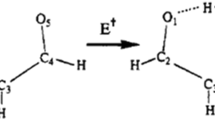Abstract
The potential-energy surfaces (PES's) of HAB molecules and HAB+ ions with the diatomic cores AB=CN−, BO−, BeF−, N2, CO, BF, CP−, BS−, NP, CS, BCl, SiN−, AlO−, SiO, AlF, SiP−, AlS−, P2, SiS, and AlCl, which contain 10 valence electrons, have been calculated by the nonempirical MO-LCAO-SCF method with subsequent consideration of electron correlation in the framework of the third-order Møller—Plesset (MP3) method, and the isomerization realized by a 1,2-hydrogen shift in them has been studied. The similarities and differences in the form of the PES's corresponding to the migration of Li+ (which was previously investigated) and the migration of H+ around AB have been traced, and the geometric characteristics and relative energies of the isomers, as well as the heights of the activation barriers between them, have been compared. An attempt has been made to relate the differences in the properties to differences in the electronic structure of HAB and LiAB.
Similar content being viewed by others
Literature Cited
V. V. Yakobson, D. G. Musaev, and O. P. Charkin, Zh. Strukt. Khim.,27, No. 6, 18–30 (1986).
V. V. Yakobson, D. G. Musaev, and O. P. Charkin, Zh. Strukt. Khim.,29, No. 4, 20–30 (1988).
V. V. Yakobson, D. G. Musaev, and O. P. Charkin, Zh. Strukt. Khim.,30, No. 1, 19–28 (1989).
O. P. Charkin and T. S. Zyubina, Koord. Khim.,12, No. 8, 1011–1019 (1986).
P. J. Bruna, G. Hirsch, R. J. Buenker, and S. D. Peyerimhoff, in: J. Berkowitz and K. Groeneveld (editors), Molecular Ions, Plenum, New York (1983), p. 309.
G. Berthier, F. Puazat, and T. Yuangi, J. Mol. Struct. THEOCHEM,107, No. 1, 39–49 (1984).
T. S. Zyubina and O. P. Charkin, Zh. Neorg. Khim.,28, No. 11, 2732–2741 (1983).
T. S. Zyubina and O. P. Charkin, Zh. Neorg. Khim.,30, No. 11, 2739–2751 (1985).
R. H. Nobes, W. J. Bouma, and L. Radom, Chem. Phys. Lett.,96, No. 6, 497–503 (1982).
P. K. Pearson and H. F. Schaefer, III, J. Chem. Phys.,62, No. 1, 250–259 (1975).
K. S. Krasnov (editor), Molecular Constants of Inorganic Compounds [in Russian], Khimiya, Leningrad (1979).
M. T. Nguyen, J. Mol. Struct. THEOCHEM,139, No. 1, 145–153 (1986).
T. S. Zyubina and O. P. Charkin, Zh. Neorg. Khim.,24, No. 10, 2595–2604 (1979).
V. V. Yakobson, T. S. Zyubina, and O. P. Charkin, Zh. Strukt. Khim.,30, No. 3, 27–32 (1989).
R. H. Nobes and L. Radom, Chem. Phys.,60, No. 1, 1–11 (1981).
H. J. Köhler and H. Lischka, Chem. Phys. Lett.,98, No. 5, 454–462 (1983).
D. G. Musaev, V. V. Yakobson, N. M. Klimenko, and O. P. Charkin, Koord. Khim.,13, No. 9, 1188–1197 (1987).
O. P. Charkin, Zh. Strukt. Khim.,24, No. 2, 87–98 (1983).
O. P. Charkin, Izv. Akad. Nauk SSSR, Ser. Khim., No.11, 2389–2494 (1972).
Additional information
Institute of New Chemical Problems, Academy of Sciences of the USSR. Translated from Zhurnal Strukturnoi Khimii, Vol. 32, No. 2, pp. 3–11, March–April, 1991.
Rights and permissions
About this article
Cite this article
Musaev, D.G., Yakobson, V.V. & Charkin, O.P. Theoretical study of isomerization by a 1,2-hydrogen shift in HAB molecules and HAB+ ions with 10 valence electrons. J Struct Chem 32, 161–168 (1991). https://doi.org/10.1007/BF00777181
Received:
Issue Date:
DOI: https://doi.org/10.1007/BF00777181




